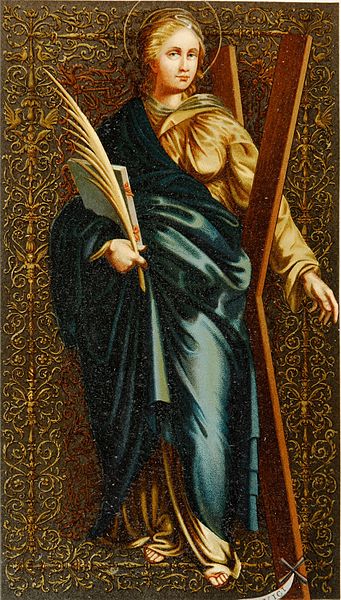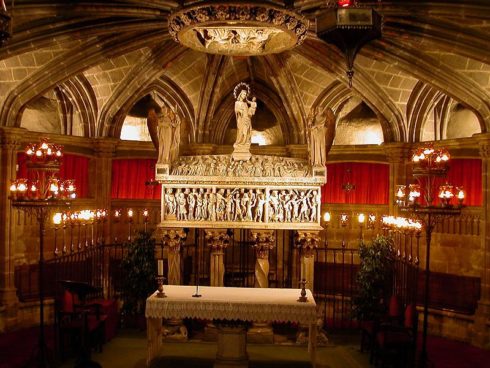Saint Eulalia of Barcelona
 A Spanish martyr in the persecution of Diocletian (February 12, 304), patron of the cathedral and city of Barcelona, also of sailors. The Acts of her life and martyrdom were copied early in the twelfth century, and with elegant conciseness, by the learned ecclesiastic Renallus Grammaticus (Bol. acad. hist., Madrid, 1902, XLI, 253-55). Their chief historical source is a Latin hymn of the middle of the seventh century by Quiricus, Bishop of Barcelona, friend and correspondent of St. Ildephonsus of Toledo and of Tajo, Bishop of Saragossa. This hymn, identical with that of Prudentius (Peristephanon, III) for the feast of St. Eulalia of Merida (December 10, 304), was preserved in the Visigothic Church and has reached us through the Mozarabic Liturgy.
A Spanish martyr in the persecution of Diocletian (February 12, 304), patron of the cathedral and city of Barcelona, also of sailors. The Acts of her life and martyrdom were copied early in the twelfth century, and with elegant conciseness, by the learned ecclesiastic Renallus Grammaticus (Bol. acad. hist., Madrid, 1902, XLI, 253-55). Their chief historical source is a Latin hymn of the middle of the seventh century by Quiricus, Bishop of Barcelona, friend and correspondent of St. Ildephonsus of Toledo and of Tajo, Bishop of Saragossa. This hymn, identical with that of Prudentius (Peristephanon, III) for the feast of St. Eulalia of Merida (December 10, 304), was preserved in the Visigothic Church and has reached us through the Mozarabic Liturgy.
There is no reason to doubt the existence of two distinct saints of this name, despite the over-hasty and hypercritical doubts of some. The aforesaid Quiricus of Barcelona and Oroncius of Merida were present at the tenth council of Toledo (656). The latter had already founded (651) a convent of nuns close by the basilica of the celebrated martyr of his episcopal city, had written a rule for its guidance, and given it for abbess the noble lady Eugenia. Quiricus now did as much for the basilica and sepulchre of the martyr of Barcelona, close to whom he wished to be buried, as we read in the last lines of the hymn. The inscriptions on many Visigothic altars show that they contained relics of St. Eulalia; except in the context, however, they do not distinguish between the martyr of Barcelona and the one of Merida. On an altar in the village of Morera, Province of Badajoz, we find enumerated consecutively Sts. Fructuosus and Augurius (Tarragona), St. Eulalia (Barcelona), St. Baudilius (Nimes), and St. Paulus (Narbonne). The Visigothic archaeology of Eastern Spain has been hitherto poor in hagiological remains; nevertheless, a trans-Pyrenean inscription found at Montady near Beziers mentions a basilica dedicated to the martyrs Sts. Vincentius, Ines, and Eulalia (of Barcelona). Until November 23, 874, the body of the Barcelona martyr reposed outside the walls of the city in the church of Santa Maria del March On that date both the body and the tomb were transferred to his cathedral by Bishop Frodoinus. In memory of this act he set up an inscription yet preserved in the Muséo Provincial of Barcelona (no. 864); see also volume XX of Florez, “España Sagrada”, for a reproduction of the same. Not long before this the martyr, St. Eulogius, having occasion to defend the martyrs of Cordova for their spontaneous confession of the Christian Faith before the Mussulman magistrates, quoted the example of St. Eulalia of Barcelona, and referred to the ancient Acts of her martyrdom. Her distinct personality is also confirmed by the existence of an ancient church and monastery in Cordova that bear the name of the Barcelona martyr; this important evidence is borne out by the Mozarabic calendars examined by the learned Dom Ferotin.
F. FITA (Catholic Encyclopedia)







